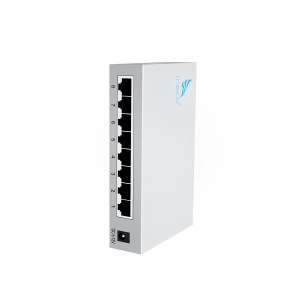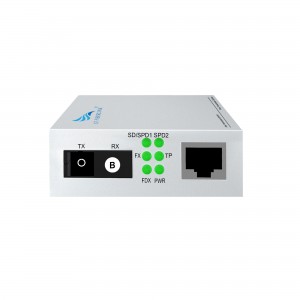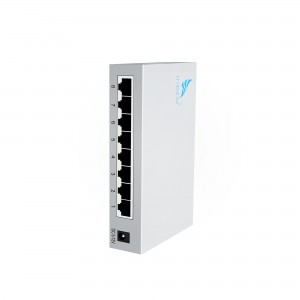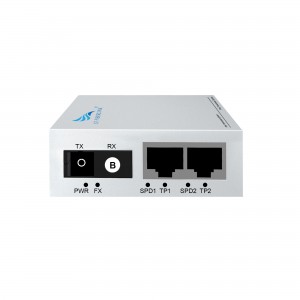2-port 10/100M WDM Media Converter (Single-mode Dual-fiber SC)
2-port 10/100M WDM Media Converter (Single-mode Dual-fiber SC)
Product Features:
Introducing the Digital Fiber Converter: Revolutionizing Communication Technology
Huizhou Changfei Optoelectronics Technology Co., Ltd. is pleased to present our latest innovation in communication equipment, the Digital Fiber Converter. With over a decade of experience in the industry, we are dedicated to providing cutting-edge solutions that meet the evolving needs of our customers.
The Digital Fiber Converter combines the power of optical and electrical technology in a single-mode dual-fiber design. It acts as a bridge between optical networks and wireless devices, enabling seamless and efficient transmission of data. With its superior performance and reliability, this converter is set to revolutionize the way we communicate.
Key Features:
1. Dynamic LED Indicator Light: Our Digital Fiber Converter is equipped with a dynamic LED indicator light that provides real-time status updates. This allows for quick and easy troubleshooting, ensuring a seamless user experience.
2. Easy to Use: We understand the importance of simplicity in today’s fast-paced world. That is why our converter is designed to be user-friendly, with plug and play functionality. It eliminates the need for complex installations, saving valuable time and effort.
3. Iron Shell Design: Durability is a top priority when it comes to communication equipment. The Digital Fiber Converter features an iron shell design, providing robust protection against external factors and ensuring long-lasting performance.
4. High Performance: Our converter delivers unrivaled performance, with ultra-low latency and high transmission speeds. It supports a wide range of applications, making it ideal for both residential and industrial environments.
At Huizhou Changfei Optoelectronics Technology Co., Ltd., we take pride in our state-of-the-art production base, spanning 20,000 square meters. Our dedicated team of over 30 research and development experts work tirelessly to ensure that our products meet the highest standards of quality and innovation.
As a leading manufacturer of communication equipment, we specialize in various products, including 5G communication equipment, 10 Gigabit core switches, industrial-grade cloud network management switches, fiber optic transceivers, smart PoE switches, network switches, wireless bridges, and optical modules.
The Digital Fiber Converter represents our commitment to excellence and our drive to provide innovative solutions to our customers. It is an essential tool for businesses and individuals seeking to enhance their communication networks and achieve seamless connectivity.
In conclusion, the Digital Fiber Converter by Huizhou Changfei Optoelectronics Technology Co., Ltd. is a game-changer in the field of communication technology. Its unique combination of optical and electrical capabilities, coupled with its user-friendly design and high performance, makes it the ideal choice for all communication needs. Experience the future of communication by integrating our Digital Fiber Converter into your network infrastructure.
What This Product Does
◇ The CF-102SW-20 is a media converter designed to convert 100BASE-FX fiber to 100Base-TX copper media or vice versa. Designed under IEEE 802.3u 10/100Base-TX and 100Base-FX standards, the CF-102SW-20 is designed for use with single-mode fiber cable utilizing the SC-Type connector. The CF-102SW-20 supports longwave (LX) laser specification at a full wire speed forwarding rate. It works at 1310nm on both transmitting and receiving data.
◇ Other features of this module include the ability to be used as a stand alone device (no chassis required), Auto MDI/MDI-X for TX port, and front panel status LEDs. The CF-102SW-20 will transmit at extended fiber optic distances utilizing single-mode fiber up to 20 kilometers.
Other Features
◇ Besides, this media converter can be used as a standalone device (no rack required) or used with CF FIBERLINK’s CF-2U14 rack for auto MDI/MDI-X in TX port in which duplex mode is automatically negotiated.
technical parameter:
| Model | CF-102SW-20 | |
| Interface Characteristics | ||
| Fixed Port | 1* 10/ 100Base-TX RJ45 port
1* 155M uplink SC fiber port |
|
| Ethernet Port | 10/ 100Base-TX auto-sensing, full/half duplex MDI/MDI-X self-adaption | |
| Twisted Pair
Transmission |
10BASE-T: Cat3,4,5 UTP(≤100 meter)
100BASE-T: Cat5e or later UTP(≤100 meter) |
|
| Optical Port | Default optical module is single-mode dual-fiber 20km, SC port | |
| Wavelength/Distance | single mode: 1310nm 0~40KM ,1550nm 0~120KM | |
| Chip Parameter | ||
| Network Protocol | IEEE802.3 10BASE-T, IEEE802.3i 10Base-T,IEEE802.3u 100Base-TX, IEEE802.3u 100Base-FX, IEEE802.3x | |
| Forwarding Mode | Store and Forward(Full Wire Speed) | |
| Switching Capacity | 0.4Gbps | |
| Buffer Memory | 0.3Mpps | |
| MAC | 1K | |
| LED Indicator | Fiber | FX(green) |
| rate | SD/SPD1 (green)SPD2: 10/ 100 (green) | |
| Data | TP (green) | |
| Single / duplex | FDX (green) | |
| Power | PWR (green) | |
| Power | ||
| Working Voltage | AC:100-240V | |
| Power Consumption | Standby<1W, Full load<3W | |
| Power Supply | DC:5V/2A industrial power supply | |
| Lightning protection &Certification | ||
| Lightning protection | Lightning protection: 4KV 8/20us, Protection level: IP30 | |
| Certification | CCC;CE mark, commercial; CE/LVD EN60950;FCC Part 15 Class B; RoHS | |
| Physical Parameter | ||
| Operation TEMP | -20~+55°C;5%~90% RH Non condensing | |
| Storage TEMP | -40~+85°C;5%~95% RH Non condensing | |
| Dimension (L*W*H) | 94mm* 71mm*27mm | |
| Installation | Desktop, CF-2U14 slot rack | |
Product Size:
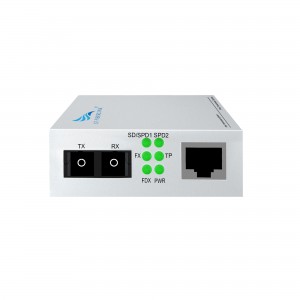
Product application diagra:

How to choose a fiber optic transceiver?
Optical fiber transceivers break the 100-meter limitation of Ethernet cables in data transmission. Relying on high-performance switching chips and large-capacity caches, while truly achieving non-blocking transmission and switching performance, they also provide balanced traffic, isolation and conflict. Error detection and other functions ensure high security and stability during data transmission. Therefore, fiber optic transceiver products will still be an indispensable part of actual network construction for a long time. So, how should we choose fiber optic transceivers?
1. Port function test
Mainly test whether each port can work normally in the duplex state of 10Mbps, 100Mbps and half-duplex state. At the same time, it should be tested whether each port can automatically select the highest transmission speed and automatically match the transmission rate of other devices. This test can be included in other tests.
2. Compatibility test
It mainly tests the connection ability between the optical fiber transceiver and other devices compatible with Ethernet and Fast Ethernet (including network card, HUB, Switch, optical network card, and optical switch). The requirement must be able to support the connection of compatible products.
3. Cable connection characteristics
Test the fiber optic transceiver’s ability to support network cables. First, test the connection ability of Category 5 network cables with lengths of 100m and 10m, and test the connection ability of long Category 5 network cables (120m) of different brands. During the test, the optical port of the transceiver is required to have a connection capability of 10Mbps and a rate of 100Mbps, and the highest must be able to connect to a full-duplex 100Mbps without transmission errors. Category 3 twisted pair cables may not be tested. Subtests can be included in other tests.
4. Transmission characteristics (transmission loss rate of data packets of different lengths, transmission speed)
It mainly tests the packet loss rate when the optical fiber transceiver optical port transmits different data packets, and the connection speed under different connection rates. For the packet loss rate, you can use the test software provided by the network card to test the packet loss rate when the packet size is 64, 512, 1518, 128 (optional) and 1000 (optional) bytes under different connection rates. , the number of packet errors, the number of packets sent and received must be more than 2,000,000. Test transmission speed can use perform3, ping and other software.
5. The compatibility of the whole machine to the transmission network protocol
It mainly tests the compatibility of fiber optic transceivers to network protocols, which can be tested in Novell, Windows and other environments. The following low-level network protocols such as TCP/IP, IPX, NETBIOS, DHCP, etc. must be tested, and the protocols that need to be broadcast must be tested. Optical transceivers are required to support these protocols (VLAN, QOS, COS, etc.).
6. Indicator status test
Test whether the status of the indicator light is consistent with the description of the panel and the user manual, and whether it is consistent with the current status of the fiber optic transceiver.








